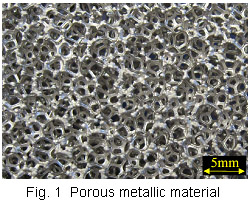 It is well known that smoothing configuration is effective to reduce aerodynamic noise from high-speed vehicles. However, in the case of components such as pantographs that are subjected to strong aerodynamic forces, smooth configurations and the stability of aerodynamic characteristics are often conflict with each other. It is a critical issue, therefore, to significantly reduce the aerodynamic noise emitted from pantographs. To address this, the RTRI has developed a technique to reduce aerodynamic noise by pasting a porous metallic material onto the surface (Fig. 1).
It is well known that smoothing configuration is effective to reduce aerodynamic noise from high-speed vehicles. However, in the case of components such as pantographs that are subjected to strong aerodynamic forces, smooth configurations and the stability of aerodynamic characteristics are often conflict with each other. It is a critical issue, therefore, to significantly reduce the aerodynamic noise emitted from pantographs. To address this, the RTRI has developed a technique to reduce aerodynamic noise by pasting a porous metallic material onto the surface (Fig. 1).
In wind tunnel tests, the RTRI confirmed that a Shinkansen pantograph partially
covered with a porous resin material is featuring an aerodynamic noise reduction
effect equivalent to that of a porous metallic material reduced aerodynamic
noise by 1 to 3 dB (Fig. 2). The method of pasting porous metallic material
onto pantographs through the bonding and riveting was devised, and it was confirmed
as having sufficient adhesion strength for practical purposes. The RTRI implemented
a running test on a Shinkansen pantograph treated with the porous metallic
material (Fig. 3) to confirm its ability to reduce aerodynamic noise without
adversely affecting the current-collecting performance. In the running test
over a period of several months, no problems were found with the adhesion performance
of the porous metallic material on the pantograph surface.
The techniquefs applicability to objects whose configuration is hard to be smoothed is expected to result in its widespread use as a means to reduce aerodynamic noise.
|